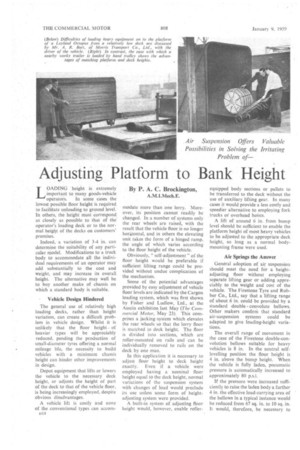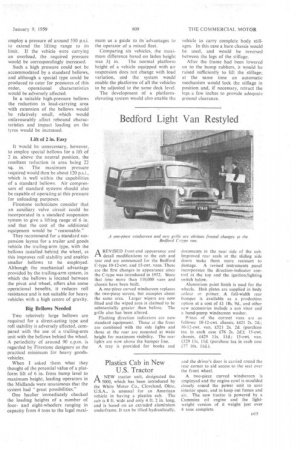Adjusting Platform to Bank Height
Page 58

Page 59

If you've noticed an error in this article please click here to report it so we can fix it.
By P. A. C. Brockington,
A.M.I.Mech.E. LOADING height is extremely important to many goods-vehicle operators. In some cases the lowest possible floor height is required to facilitate unloading to ground. level.• In others, the height must correspond' as closely as possible to that of the operator's loading deck or to the normal height of the decks on customers' premises.
Indeed, a variation of 3-4 in. can determine the suitability of any particular model. Modifications to a truck body to accommodate all the individual requirements of an operator may add substantially to the cost and weight, and may increase its overall height. The alternative may well be to buy another make of chassis on which a standard body is suitable.
Vehicle Design Hindered
The general use of relatively high loading decks, rather than height variation, can create a difficult problem in vehicle design. Whilst it is unlikely that the floor height of heavier types will be appreciably reduced, pending the production of small-diameter tyres offering a normal mileage life, the necessity to build vehicles with a minimum chassis height can hinder other improvements in design.
Depot equipment that lifts or lowers the vehicle to the necessary deck height, or adjusts the height of part of the deck to that of the vehicle floor, is being increasingly employed, despite obvious disadvantages.
A vehicle lift is costly and none of the conventional types can accomn14 modate more Than one lorry. Moreover, its position cannot readily be changed. In a number of systems only the rear wheels are raised, with the result that the vehicle floor is no longer horizontal, and in others the elevating unit takes the form of a hinged ramp, the angle of which varies according to the floor height of the vehicle.
Obviously, " self-adjustment " of the floor height would be preferable if sufficient lifting range could be provided without undue complication of the mechanism.
Some of the potential advantages provided by easy adjustment of vehicle floor levels are indicated by the Cargon loading system, which was first shown by Fisher and Ludlow, Ltd., at the Austin exhibition last May (The Commercial Motor, May 23). This comprises a jacking -system which elevates the rear wheels so that the lorry floor is matched to deck height. The floor is divided into sections, which are roller-mounted on rails and can be individually removed to rails on the deck by one man.
In this application it is necessary to adjust floor height to deck height exactly. Even if a vehicle were employed having a nominal floor height equal to the deck height, normal variations of the suspension system with changes of load would preclude its use unless some form of heightadjusting system were provided.
A built-in system of adjusting floor height would, however, enable roller equipped body sections or pallets to be transferred to the deck without the use of auxiliary lifting gear. In many cases it would provide a less costly and speedier alternative to employing fork trucks of overhead hoists.
A lift of around 6 in. from bump level should be sufficient to enable the platform height of most heavy vehicles to be adjusted to the appropriate deck height, so long as a normal bodyMounting frame were used.
Air Springs the Answer General adoption of air suspension should meet the need for a heightadjusting floor without employing separate lifting gear or adding appreciably to the weight and cost of the vehicle. The Firestone Tyre and Rubber Co., Ltd., say that a lifting range of about 6 in. could be provided by a standard double convolute bellows. Other makers confirm that standard air-suspension systems could be adapted to give loading-height variations.
The overall range of movement in the case of the Firestone double-convolution bellows suitable for heavy vehicles is 8 in. In the neutral selflevelling position the floor height is 4 in. above the bump height. When the vehicle is fully laden, pneumatic pressure is automatically increased to approximately 80 psi.
If the pressure were increased sufficiently to raise the laden body a further 4 in. the effective load-carrying area of the bellows in a typical instance would be reduced from 67 sq. in. to 10 sq. in. It would, therefore, be necessary to employ a pressure of around 550 p.s.i. to extend the lifting range to its limit. If the vehicle were carrying an overload, the required pressure would be correspondingly increased.
Such a high pressure could not be accommodated by a standard bellows, and although a special type could be produced to cater for pressures of this order, operational characteristics would be adversely affected.
In a suitable high-pressure bellows the reduction in load-carrying area with extension of the bellows would be relatively small, which would unfavourably affect rebound characteristics and impact loading on the tyres would be increased.
Lift of 2 in. Easy
It would be unnecessary, however, to employ special bellows for a lift of 2 in. above the neutral position, the resultant redaction in area being 22 sq. in. The maximum pressure required would then be about 120 psi., which is well within the capabilities of a standard bellows. Air compressors of standard systems should also be capable of operating at this pressure for unloading purposes.
Firestone technicians consider that an auxiliary valve circuit could be incorporated in a standard suspension system to give a lifting range of 6 in. and that the cost of the additional equipment would be "reasonable."
They recommend for a standard suspension layout for a trailer and goods vehicle the trailing-arm type, with the bellows installed behind the wheel, as this improves roll stability and enables smaller bellows to be employed. Although the mechanical advantage provided by the trailing-arm system, in which the bellows is located between the pivot and wheel, offers also some operational benefits, it reduces roll resistance and is not suitable for heavy vehicles with a high centre of gravity.
Big Bellows Needed
Two relatively large bellows are required for a direct-acting type and roll stability is adversely affected, compared with the use of a trailing-arm unit with the bellows behind the wheel. A periodicity of around 90 c.p.m. is regarded by Firestone designers as the practical minimum for heavy goodsvehicles.
When I asked :them what they thought of the potential value of a platform lift of 6 in. from bump level to maximum height, leading operators in the Midlands were unanimous that the system had great possibilities."
One haulier immediately checked the loading heights of a number of fourand eight-wheelers ranging in capacity from 4 tons to the legal maxi
mum as a guide to its advantages to the operator of a mixed fleet. Comparing six vehicles, the maximum difference based on laden height was 31 in. The normal platform height of a vehicle equipped with air suspension does not change with load variation, and the system would enable the platforms of all the vehicles to be adjusted to the same deck level.
The development of a platformelevating system would also enable the vehicle to carry complete body stillages. In this case a bare chassis would be used, and would be reversed between the legs of the stillage.
After the frame had been lowered on to the bump rubbers, it would be raised sufficiently to lift the stillage; at the same time an automatic mechanism would lock the stillage in position and, if necessary, retract the legs a few inches to provide adequate ground clearance.
























































































































